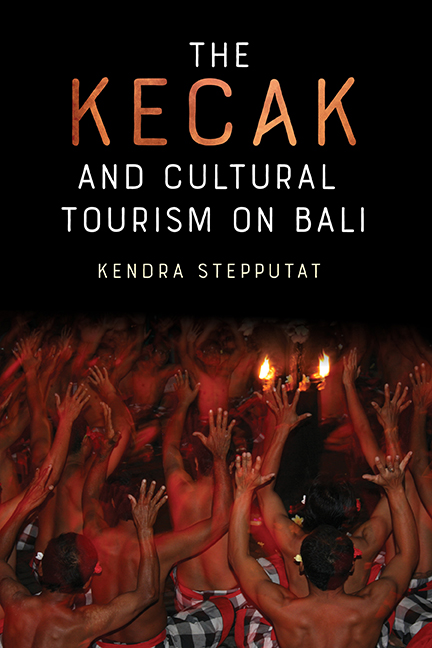Book contents
- Frontmatter
- Contents
- Acknowledgments
- Note to the Reader
- Introduction
- Part 1 The Present
- Part 2 The History
- Appendix 1 Kecak dan Wisata Budaya di Bali (Indonesian Summary)
- Appendix 2 Kecak Groups of Bali in 2000–2001 (Badung and Gianyar)
- Appendix 3 Facsimile of a Letter from Walter Spies to Leo Spies, 1932
- Glossary
- Bibliography
- Index
2 - Kecak: The Dance
Published online by Cambridge University Press: 07 October 2022
- Frontmatter
- Contents
- Acknowledgments
- Note to the Reader
- Introduction
- Part 1 The Present
- Part 2 The History
- Appendix 1 Kecak dan Wisata Budaya di Bali (Indonesian Summary)
- Appendix 2 Kecak Groups of Bali in 2000–2001 (Badung and Gianyar)
- Appendix 3 Facsimile of a Letter from Walter Spies to Leo Spies, 1932
- Glossary
- Bibliography
- Index
Summary
Kecak dance movement elements are based on many different ritual and secular, non-narrative as well as dramatic dance traditions. The well-documented genesis and development of kecak in the twentieth century allows us to accurately trace movement influences from other genres, individual dancers, and choreographers. Interestingly, the movement repertoires of the soloists and the pengecak group have a different background and line of development. The Balinese dramatic performing arts genres wayang wong and the younger sendratari ramayana form the basis for the soloists, whereas the movement repertoire of the pengecak group is derived directly from the ritual sanghyang, to which contemporary choreographers keep adding new elements. The reason for this diversity lies in the history of kecak itself, which is elaborated in the second part of this book.
In order to understand the many layers of movements, I will first examine the pengecak movement elements—sanghyang derived and contemporary— which have not yet been described or researched in detail. Regarding the soloists’ repertoire, it is more enlightening first to look into the genres of origin for the solo dance repertoire and then to identify which elements have been added or adapted into kecak.
Movements of the Pengecak Group
The pengecak group acts as a moving choir, whose synchronized movements are more or less coordinated. While the performers are bare chested, their lower bodies are dressed in a long loincloth (babuletan) covered by a sash (saput). The saput is made of kain poleng. Both articles of clothing are secured around the waist by a long, mostly red band (umpal).
The most common and—with respect to the origin and development of kecak—the oldest choreographic element used by the pengecak group is the sitting in concentric circles facing the center (figure 2.1). In kecak performances today, the pengecaks sit in this position, as well as several other ones. Over the course of the performance, they stand up, walk to a new position, or take part in the play. When the pengecaks sit, mainly the movements they perform with their upper bodies are visible to the audience. The seating position is cross-legged (masila). All movements described below are carried out while the pengecaks are seated on the ground in masila.
- Type
- Chapter
- Information
- The Kecak and Cultural Tourism on Bali , pp. 44 - 85Publisher: Boydell & BrewerPrint publication year: 2021



